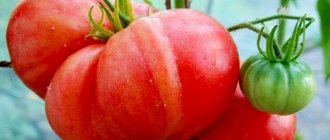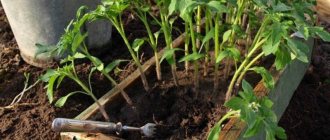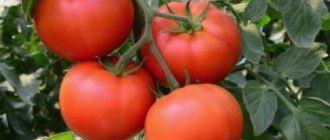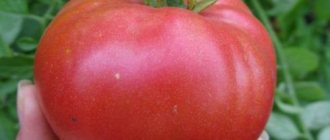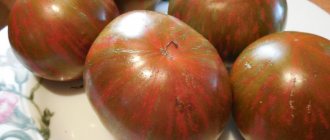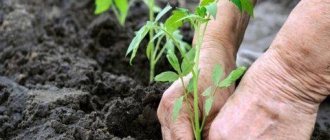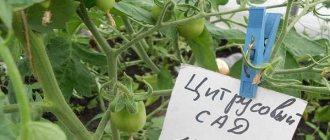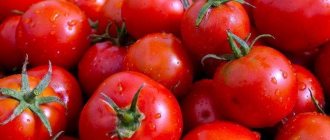Dusya red will appeal to those who love medium-sized tomatoes. The variety appeared in Russia and was tested in the climatic conditions of Siberia. Designed for growing outdoors or in seasonal greenhouses.
| Height | Landing location | Ripening time | Fruit color | Fruit size | Origin | Fruit shape |
| Medium height | Greenhouse, Open ground | Mid-season | Reds | Average | Variety | Plum-shaped or oval |
Description of the variety
The red Dusya tomato shows the best results in greenhouse conditions, but many people plant it in the open air . Tomatoes are grown by seedlings, the first harvest is obtained within 90-100 days from the moment of planting. Mid-early tomatoes are planted both in the south of the country and in the northern regions. As befits a hybrid, this variety is highly resistant to bad weather and disease.
Distinctive features
The height of the bush varies from 80 to 150 cm . The variety is unpretentious in care, but requires timely gartering and pinching. The clusters are medium leafy; 4-7 tomatoes are produced on one plant. Externally, the leaves are similar to potato leaves, dark green in color.
Characteristics of tomatoes and yield
Dusya red has an oval shape and a rich, bright color . Externally, the tomato resembles a bell pepper. The pulp is dense, there are few seed chambers. The weight of one vegetable is about 200 g. The variety is universal in use and is valued for its high taste. From 1 sq. m, gardeners harvest about 7 kg of beautiful and neat tomatoes.
Planting seedlings in the ground
Experts recommend for 1 sq. m. place no more than 3 bushes. Before planting plants in the garden, the soil should be prepared. The soil needs to be dug up, cleared of weeds, and fertilizer applied. Next, you need to make holes, water, and carefully plant the seedlings.
The main work has already been done. However, we must not forget that seedlings need some care. The main care activities are as follows:
- Watering. The bushes should be watered regularly, once a week will be enough. For irrigation, you can only use warm water.
- Loosening and weeding. The procedures are mandatory. They help protect plants from weeds. Thanks to loosening, air enters the root part of the plants.
- Tying. Since the bushes are tall, they require tying to a support.
Note! You can get the maximum result if you grow a tomato with 2-3 stems.
How to grow seedlings
Red Dusya seedlings are prepared 50-60 days before planting the plants in the ground . During this time, the sprouts get used to external conditions and adapt to the air temperature. The germination of seedlings largely depends on the quality of the seeds and soil.
Seed preparation
Before planting, seeds must undergo careful selection .
First of all, inspect them for external abnormalities. If you notice damage or spots on the surface, do not plant the seeds. Choose only healthy and even seed. We also recommend that you carefully read the information on the packaging and trust only trusted manufacturers. After selection, the seeds are disinfected . To do this, place them in the sun for a week, for example, on a windowsill or balcony. The sun's rays will warm them up from all sides and destroy pathogens on the surface.
After disinfection, the seeds are germinated . Wrap them in a damp cloth and place them on a plate. It is advisable to germinate in a bright and warm place. This procedure improves the germination of the material and strengthens its immunity. For better results, gardeners add Epin or Mortar to the liquid. Growth stimulants accelerate the development of tomatoes.
It will be interesting:
Top 25 sweetest tomato varieties
How to Grow Sweet Tomatoes
Container and soil
Any clean and dry container is suitable for seedlings, for example, plastic glasses or a wooden box .
The most popular are plastic cassettes, which can be purchased at any gardening store. Their value lies in the fact that they are convenient when transplanting seedlings into the ground. Many gardeners prefer to prepare the soil for seedlings themselves. For this you need soil from the garden, humus, peat and river sand. The main thing is to remember that such soil must be disinfected with a solution of potassium permanganate.
Important! If you don’t want to spend time and effort preparing the soil, ready-made “Universal” or “Strong” soils will come to the rescue. They are affordable and already contain all the necessary nutrients for the development of sprouts.
Sowing
Pour soil into a container and pour plenty of warm water over it, leave for six hours . Then make grooves 1 cm deep in the ground and place the seeds in them. Sprinkle soil on top and moisten again. It is recommended to cover the seedlings with glass or film and remove them after the first shoots appear.
Growing and care
Caring for seedlings does not require special effort or special knowledge . The main thing is to follow the watering regime. Moisten the seedlings every 7-10 days. It is important to prevent the soil from drying out and not to over-wet it. It is recommended to use a pipette or syringe for watering so that the water gets directly under the root, bypassing the stems and leaves. Remember that excess moisture increases the risk of developing fungal diseases.
Important! Grow seedlings in a warm and bright place. Avoid drafts and be careful with air conditioning.
The ideal air temperature for seedlings is at least 20 degrees . If the plant does not have enough light, use additional lighting with fluorescent lamps. Two weeks after planting, organize the first feeding. Liquid bird droppings and ash solution are excellent fertilizers.
Open ground tomatoes in Siberia
Red Dusya - from seeds to harvest
The planting time is calculated from the time of transplantation into a greenhouse or open ground. The calculated value is the age of the seedlings; for Dusya red it is 50–60 days. The age of the seedlings is subtracted from the expected date of transplantation and the time for sowing seeds for seedlings is obtained.
See also
Description of the Emperor tomato variety, features of cultivation and careRead
Before sowing, the seeds should be kept in a solution of potassium permanganate (the solution is slightly pink) for 15–20 minutes. Treat the soil with temperature (in the oven), a solution of potassium permanganate, and a fungicide (Fitosporin-M). It is worth sowing in plastic seedling boxes, the height of the walls of the seedling box is not higher than 7 cm. Moisten the soil well, spread the seeds according to a 2.5 * 4 cm pattern, sprinkle with a layer of humus or soil of 1.5 - 2 cm.
Before the shoots appear, cover the boxes with film or glass. Maintain the room temperature at 23 – 25 °C.
When planting in the ground, follow the manufacturer’s recommendations: place no more than three red Dusya bushes per 1 square meter. During the season, feed the tomatoes several times with mineral fertilizers. Water regularly (every 5 days), abundantly . Tie the bush to a support, lead it into 2 - 3 stems.
For lovers of yellow tomatoes, we can recommend the yellow Dusya variety - summer residents speak well of it.
How to grow tomatoes
After two months, the seedlings are transplanted into the garden . The best place for tomatoes is light and windless areas that are located away from ponds and underground groundwater.
Landing
They are preparing for planting in the fall . Be sure to dig up the beds and remove all debris and weeds from them. Fertilize the soil with liquid manure. With the arrival of spring, dig up the soil again and water it with Bordeaux mixture. The mixture will disinfect the area and destroy dangerous microorganisms.
Dusya red is planted at a distance of 50 cm from each other . We recommend installing wooden stakes next to each sprout to which adult bushes will be tied. After planting the seedlings in the ground, water the beds generously with warm water. The next watering will be only in 10 days.
Care
Subsequently, the tomatoes are moistened every 8-11 days .
The frequency of watering depends on weather conditions. If the summer is dry and hot, plants need more water. However, do not flood the beds: this may cause the tomatoes to crack. Many gardeners use a drip system because it helps control water flow and is suitable for applying liquid root fertilizers. Dusya red needs timely fertilizers . The most common ones are:
- manure or droppings;
- ammonium nitrate;
- nitrophoska;
- nettle based solution;
- ash solution;
- yeast;
- Bordeaux mixture.
Fertilize every two weeks . It is best to alternate organic fertilizers with mineral ones. Be especially careful with nitrogen-containing substances, as an excess of them will only harm the tomatoes.
Important! Do not forget about loosening the soil and removing weeds. Loosening improves oxygen access to the roots, and removing weeds is necessary to maintain the necessary microflora in the beds. Carry out these procedures every week.
Features of cultivation and possible difficulties
The variety requires mandatory formation . Form Dusya red into one stem, removing all lateral shoots and shoots. When forming, the main thing is not to harm the bush; the stepsons are cut off carefully. Formation and pinching are necessary to ensure that leaves and shoots do not obscure sunlight.
Gardeners also face difficulties in applying fertilizers incorrectly . For example, if you add ammonium nitrate or urea in excess, yellow spots will appear on the leaves and the plant will begin to dry out. This occurs due to an excess of nitrogen. In this case, gardeners advise watering the beds abundantly and laying straw on them.
Tomato Dusya red - description and characteristics of the variety
Description
The plant is indeterminate and requires staking to the pore.
The bush is formed into two stems. The fruits are collected in clusters of 10-15 pieces. The skin is dense, the flesh is juicy, sweet, with a high content of dry matter. Dusya red tomatoes are ideal for pickling and canning. The advantage of the variety is good transportability of the fruit, resistance to cracking and blossom end rot. The variety is mid-early, the first fruits ripen 95-100 days after emergence. The plant is resistant to common diseases of the nightshade family. Fruiting continues until frost.
tomato Dina - description and characteristics of the variety
Growing and care
Tomato Dusya red prefers illuminated areas and loves warmth
Therefore, it is important to decide in advance on the landing site. If the plant receives enough light, it will be able to produce more crops in the future.
The soil for planting should be loamy or sandy loam.
Before sowing, the seeds are treated with a solution of potassium permanganate. Seeds from the previous year's harvest are used; old seeds lose their viability. Sowing time is the end of March. After the appearance of 4 leaves, the seedlings dive into the greenhouses.
Before planting in a permanent growing area, the soil is filled with humus and superphosphate. After planting the tomatoes, the row spacing is watered and the holes are mulched.
Obtaining seedlings
Seedlings can be grown independently in greenhouses under film. Tomato seedlings must be watered systematically (at least 3 times a day); after a month, the film begins to be periodically opened slightly to harden the seedlings; over time, it is completely removed. After 50-60 days, the seedlings are planted in open ground and mulched with peat.
During cultivation they provide care - loosening the soil, watering, killing weeds. The land must be prepared in advance before planting. Dig holes and add fertilizer in the form of compost or humus. They will begin to bloom in just one month. The plant must be planted in the last days of May or at the beginning of June. You should pay attention to weather conditions
It is important that the soil has time to warm up before planting, otherwise the plant may die. When growing tomatoes in seedlings, prepare a container and add a mixture of peat and humus. Next, the soil is moistened, and only then the seeds are planted to a depth of two to three centimeters. The plant must be watered once every ten days.
It is also important to use fertilizing (2 will be enough). The first occurs after the first shoots, and the second after ten days.
Tomatoes require care, albeit minor.
It is important to loosen the soil from time to time. Thanks to this, the root system will be able to receive heat and moisture
Therefore, the more often the gardener loosens the beds, the better. It is also important to water the plant, but the main thing in this matter is not to overdo it. Since a large amount of water on the site can harm the plant, which can cause it to die in the future.
tomato Irish liqueur - description and characteristics of the variety
Top dressing
Before planting in open ground, the fertile layer of soil must be mixed with complex fertilizers. If the soil is acidic, lime or dolomite flour is added to it.
You can feed the plants with special fertilizers purchased in stores, or you can prepare them yourself. The first harvest can already be harvested from the plot in 95-100 days. True, the first fruits will be small in size.
Plants can be affected by stem nematode. When bushes are affected, thickening of the petioles and veins is observed. The affected areas of the plant first become brittle and later soft. To combat nematodes, thiazone powder is used at the rate of 1-1.5 kg per 10 m2.
tomato Indio F1 - description and characteristics of the variety
Tomato Dusya Red
Mid-season variety for greenhouses and temporary shelters.
The fruits are calibrated, dense, oval-plum-shaped, fleshy, with a small number of seeds.
Average weight 150-200g, the first ones up to 350g
The fruits are round, red, fleshy, weighing up to 100 grams. Intensely sweet taste.
The nuances of growing in open ground and greenhouses
When growing Dusya red in a greenhouse, pay special attention to tying the bushes to the support . In addition to the traditional method of tying to wooden stakes, gardeners actively use the Maslov method. On a thick fishing line, knots are tied every 20 cm. Next, the fishing line is cut into sections the height of the greenhouse and attached at the top opposite each bush. Using wire hooks, the tomato is tied to a fishing line and hung from the nearest loop. Maslov's method is very convenient and practical.
If you grow tomatoes in open ground, do not forget about the temperature regime . If the summer turns out to be foggy and cold, build caps for the bushes from thick film. They will help the plant survive unfavorable climatic conditions. The caps are easy to use: as soon as the weather returns to normal, they can be easily removed from the bush. This technique is especially relevant for gardeners from northern regions.
Characteristics and description of the tomato "Zinulya". Description of the tomato Dusya red and growing rules
- Semi-determinate type.
- Early, with a ripening period of 80 – 90 days.
- Productive – 10 – 15 kg per 1 sq. m. 40% of the harvest is ready by the first harvest.
- Unpretentious, suitable for areas with capricious climates.
- Suitable for greenhouse conditions and open ground.
- The height of the bush is 0.6 - 1 m.
- The stem is flexible and stable.
- The leaves are regular size, round, green.
- High immunity to diseases and stress.
- Poor transportability over long distances. Vegetables may crack and become wrinkled.
The time for sowing seeds is selected based on the weather conditions of a particular region.
It is important that by the time the seedlings are planted in a permanent place, the street has a stable above-zero temperature day and night, and also that the last spring frosts have passed
Bushes are planted no earlier than 60–65 days after emergence.
The Luna tomato is sown in separate pots and in wide containers; young shoots can easily tolerate picking. When planting, the root does not need to be shortened; the seedlings are already developing well. The main thing is not to forget about watering and feeding the seedlings, and also that young tomatoes need good lighting and warmth.
A week before moving to a permanent place, the seedlings begin to harden off - this is a prerequisite even for warm regions. Choose a method based on your capabilities; you can take the bushes out onto the loggia, into the greenhouse, or open a window in the room.
Planting and care
A site for tomatoes should be sunny, open, but if possible windless. The Luna tomato can grow in any soil, but it gives the best results in cultivated, rich, non-acidic, well-drained soil. No more than 6 seedlings are placed on one square meter.
The bushes of the variety are small, but it is advisable to tie them up, especially the brushes. They may break under the weight of the fruit. Gardeners who grow the variety recommend planting the Luna tomato up to the first tassel.
Watering and fertilizing are carried out in the usual manner for tomatoes. The first time the variety requires irrigation immediately after planting, then it is watered once a week, a little more often in hot weather.
To prevent moisture from evaporating quickly, the beds are mulched with straw or mown grass. The first feeding is necessary 2 weeks after planting, subsequent ones every 20 days.
You can use both organic and mineral complexes.
Hilling up is not a mandatory procedure. But if you notice that the bushes are beginning to weaken, you can cover the trunk a little with soil to form additional roots and increase the feeding area. Weeds are removed from the beds.
Prevention of diseases and pests
Since the variety is not susceptible to diseases and is unattractive to insects, you don’t have to worry about treatment. But basic preventive measures will not be superfluous, especially if different varieties of planting are planned.
When preparing the site, green manure is sown in spring and autumn. White mustard and alfalfa are suitable. Various aromatic herbs and flowers are planted between the rows and next to the tomato beds; marigolds, wormwood and calendula show the best results. Basil has a beneficial effect on the taste of tomatoes.
Tomatoes are not planted next to or after nightshade crops. Another 3 bad neighbors for tomatoes are corn, cabbage and fennel. Not only do these plants attract the same pests, but they also kill each other and fight for food.
Harvesting and application
The crop is harvested as it ripens .
The yield of the variety is friendly, the tomatoes ripen on the bunch at the same time. Dusya red also ripens well in indoor conditions. Harvest ripe tomatoes immediately, do not allow them to overripe. This harms the entire bush. The variety is used in the preparation of various dishes . Red Dusya is great for summer salads, combined with cucumbers and bell peppers. The sweetish taste of the vegetable adds piquancy to the dish. Tomato is also suitable for soups, such as borscht or kharcho. In addition to taste, tomatoes give dishes an appetizing scarlet color.
Due to the high content of vitamins and macroelements, tomatoes are used for preparing dietary foods. They are used to make low-calorie purees, salads, cold appetizers and sandwiches. Red Dusya goes well with various sauces and spices.
Interesting! Housewives love to make tomato juice. Its taste and benefits are undeniable; it saturates the body with vitamins. For cooking, in addition to tomatoes, you need salt and sugar to taste. Cinnamon, basil or garlic are also often added to the drink.
Tomato "Three Fat Men" large-fruited
Mid-season large-fruited.
Fruit weight up to 800 g. Height 1.1 - 1.5 m. On the main stem there are 5-6 clusters with four - five fruits.
The fruits are flat-heart-shaped, bright red, dense.
Excellent in salads and winter preparations.
15 rub.
…………………………………………………………………………………………….
Large-fruited variety of Siberian selection. Adapted to the conditions of Siberia.
Mid-ripening, fruits up to 800 g, fleshy, attractive pink in color, heart-shaped.
Very productive, up to 6 kg per plant, excellent fruit set.
18 RUR
………………………………………………………..
A variety with very large fruits. Mid-season, plant 1-1.5 m.
The tomatoes are beautiful, clearly heart-shaped, raspberry-red in color. Great taste. Productivity up to 5 kg per bush.
For cultivation in open and protected ground.
15 rub.
……………………………………………………………………………………………
Mid-season variety for open ground and greenhouses, with large raspberry-colored fruits.
The plant is up to 1 m high, the fruits are tasty, moderately ribbed, fleshy and tasty. Fruit weight 300-600 g.
Recommended for fresh use and home cooking. It is grown with moderate pinching and tying to a support.
15 rub.
Medium early, very productive, large 600-900 g. Tomatoes are round, red-scarlet in color, high tolerance to adverse weather conditions, can be grown on any soil.
Recommended for cultivation in open ground and film greenhouses.
Productivity up to 5 kg per plant.
15 rub.
………………………………………………………………………………….
Mid-ripening variety, fruits are oval-round, weighing 600-900 g or more, dark crimson in color, sugary.
Very high taste qualities. Plant height 90-130 cm.
Grown in open ground and in film greenhouses (shelters)
18 RUR
……………………………………………………………………………………….
Mid-season, very large-fruited.
Plant height is 1 - 1.2 meters. The fruits are large, the first ones up to 1 kilogram.
Dense, sugary at the break, do not crack.
In open ground, stepsons are planted only up to the first cluster.
Productivity d 6 kg/plant.
20 rub
……………………………………………………………………
Mid-season variety, up to 1.50 cm high.
Fruits up to 500 grams, large, fleshy, raspberry pink.
Not demanding on growing conditions.
For cultivation in open and closed ground.
Productivity up to 7 kg/plant.
20 rub
………………………………………………………………..
tomato Diva F
Early ripening hybrid.
It has excellent yield, high taste, transportable, dense.
Height up to 1.30 cm, fruit weight up to 150 grams, red, round “with a spout”.
For all types of processing. Productivity up to 18 kg/sq.m.
23 rub.
…………………………………………………………………
Mid-season for greenhouses and open ground.
The fruits are yellow, weighing 600 grams. Bush height up to 1.60 cm.
Meaty, with sweet pulp, without acids.
Productivity up to 5 kg/plant.
18 RUR
Mid-season, large-fruited up to 800g, with an unusual beak-shaped shape.
Cultivation in open and protected soils is recommended. Plant height from 1.2 to 1.5 m. Requires gartering and pinching.
The fruits are raspberry-pink in color, tasty, the pulp is low-seeded and very dense, which ensures good keeping quality and high pickling qualities of the fruit. Weight of tomatoes up to 800g.
18 RUR
………………………………………………………………………………………
Large-fruited, for growing in open and protected ground. The bush is powerful, 1-1.5 m high.
The fruits are cone-shaped, pink-raspberry in color, very fleshy and tasty.
For salad purposes (for “food”).
12 rub.
Mid-season, up to 1.5 m high. It is grown in open ground and film greenhouses.
The fruits are bright red, round-ribbed, weighing 600g or more. Dense, gives a harvest in any year.
Productivity reaches up to 8 kg per bush.
18 RUR
………………………………………………………………………………………….
Mid-season, large-fruited, beautiful elongated shape. The fruits are pink-raspberry, with delicate sweet pulp. Dense, not watery, resistant to cracking.
The bush is medium-sized and powerful.
Resistant to diseases and adverse weather conditions. It is grown in open ground and film greenhouses.
18 RUR
……………………………………………………………………….
Salad large-fruited variety.
Height up to 1.50 cm. The fruit is flat-round, strongly ribbed. Weight 250-350 grams (up to 800 g).
Universal use.
15 rub.
………………………………………………………………
Advantages and disadvantages of the variety
The advantages of Red Dusya, gardeners primarily include its unusual appearance . Due to its size and shape, the tomato is used as a base for stuffed dishes. The vegetable is also valued for its pleasant taste and tender pulp. Red Dusya is universal in use and rich in useful substances. In addition, the variety is characterized by excellent yield and immunity to diseases and pests.
Among the disadvantages, the need to form a bush is noted . Gartering and pinching require additional effort and time, which is not always convenient.
Features of cultivation and storage
The tallness of the bush requires proper tying and pinching. The tomato should be tied to trellises or wooden pegs stuck next to the bush. In greenhouses, you can build a crossbar over the plants and stretch a thread from it along the stem. In addition to the stem, heavy bunches of tomatoes are tied up.
When pinching, remove all branches, leaves and shoots no more than 5 cm long to the first brush, forming the main stem.
When choosing a planting site, take into account that the leaves will grow actively if there is a lot of humus in the soil.
The fruits are stored for 3-4 days due to their wateriness. It is better to regularly pick them from the clusters and use them, as this is facilitated by the long fruiting of the variety.
Farmer reviews
Gardeners' opinions about the Dusya Krasnaya variety are contradictory: some find it attractive and tasty, while others do not find it so impressive.
Elena, Tver : “Dusya red is one of my favorite varieties.
It is very tasty, the pulp literally melts in your mouth. I use it in a variety of forms: I make preparations, salads, and snacks. But the variety is also good fresh. I recommend to all". Marina, Moscow : “Dusya Krasnaya planted tomatoes for the first time, overall I was pleased with the result. The yield is good, as is the quality of the tomatoes. I planted it using seedlings and there were no problems with care.”
Evgeniy, Penza : “I expected big and beautiful tomatoes from Dusya red, like on the packaging. The end result was tomatoes of medium size and watery taste. I planted it in a greenhouse and fertilized it on time. I'll try to plant again next year. But this time I'm disappointed."
Growing tomatoes
“Dusya Krasnaya” demonstrates the best growth rates under shelters, so tomatoes are most often grown in a greenhouse. The variety can be grown from year to year by collecting the seeds yourself. However, it is important to adhere to the following rules :
- When choosing seed tomatoes, be guided not by the size of the fruit, but by the exterior of the bushes - they must be healthy and have sufficient yield;
- Seeds are selected only at the fermentation stage. To do this, the contents of the seed chambers are removed into a glass and covered with gauze for 24-48 hours. After a white coating forms on the surface of the liquid (the beginning of the fermentation process), the seeds are removed from the tomato mass, washed with water and sent for storage.
How to prepare seeds?
Seeds are prepared according to the traditional method:
- Pickling in potassium permanganate or hydrogen peroxide. Any of these solutions destroys most pathogens located on the surface of seeds within 15 minutes, thus preventing the occurrence of infectious diseases at an early stage of the growing season.
ATTENTION : Work with seeds must be carried out under sterile conditions: treat containers and equipment with chlorine solution, handle with disposable gloves, steam the soil for sowing in the oven at 60*C.
- Growth stimulation using Epin or Kornevin solutions. It is carried out within 30 minutes and allows you to increase the germination rate of seedlings by 1.5 times.
- Soaking in purified water (preferably melt water). The seed material is laid out on a plate, covered with gauze and filled with warm water. Effective soaking should last at least 12 hours. During this time, the seeds have time to become saturated with moisture, which significantly speeds up their opening when they enter the soil.
- Hardening on the top shelf of the refrigerator for 2 days. The procedure increases the immunity of future plants.
Sowing seed material
The sowing date is calculated individually based on the climate zone. To do this, subtract 50 days from the date of the last return frost.
Soil for seedlings can be purchased at the store ("Universal" or "For tomatoes and peppers" is suitable). The second option is to prepare the substrate yourself. To do this, mix garden turf, peat and sand in proportions 2:2:1, add humus in an amount of at least 10% of the total mass.
General instructions for sowing:
- Select and disinfect a suitable container (a wooden box, cut-off tetra pack, pastry molds with a depth of 7 cm or more will do);
- A 2-cm layer of charcoal or fine expanded clay is poured onto the bottom of the container, then the main soil;
- In the ground, grooves 2 cm deep are made at a distance of 4 cm from each other;
- Seeds are placed in the grooves at intervals of 2.5 cm, sprayed with “Humate” and sprinkled with peat;
- After warm watering, the seedlings are covered with film;
- When the first shoots appear, the shelter is removed and the seedlings are exposed to the light;
- Transplantation into individual containers is carried out after unfolding 2-3 sheets.
IMPORTANT : It is advisable to use peat or paper cups for picking. This will save the plants from additional stress when transplanting into the greenhouse.
Rules for planting seedlings
Seedlings are planted at approximately two months of age, when the plants have stretched up to 30 cm. At the time of planting, the average daily air temperature in the greenhouse should not fall below 15*C, and the soil temperature should not fall below 12*C. It is also necessary to take into account that for normal growing season, plants will need at least 12 hours of lighting per day.
Recommended planting pattern:
- The interval between bushes is 60 cm;
- Row spacing – 70 cm;
- Planting hole depth – 12 cm;
- The maximum planting density is 3 plants per 1 sq.m.
The best tomato varieties for the Urals and Siberia:
Before transferring the plant, the planting hole is generously spilled with warm potassium permanganate, humus and peat are added, and a little ash is poured. The plant must be installed so that its bottom leaf is 4-5 cm from the ground.
Tomato variety Lionheart
Lionheart is a very popular variety of tall tomatoes. The ripening period is 110-120 days. The height of the stem is moderate, which does not need to be pinched. The fruits are large, red, fleshy with a delicate and sweet taste. On average, you can collect up to 4 kg from each bunch, where each tomato weighs 200-250 grams. Lion's heart is an indispensable tomato in salads or slices due to its juiciness and unique taste. An excellent option for juices, sauces and dressings.
Reviews
Irina, Republic of Khakassia:
“The Dusya Krasnaya variety is one of my favorites; I’ve been planting it in a polycarbonate greenhouse for three years now. I sow seeds for seedlings in early March (first ten days), and after April 20 I transplant them into a greenhouse. Bushes of medium height, from 80 cm to 1 m, require garter, neat, minimal care. For three years, not a single bush was sick, they always bore fruit consistently.
The tomatoes are one of the first to begin to sing; only the tall Budenovka does not lag behind Dusya. The fruits taste good and look very nice; we eat them in salads, although they are also great for pickling. I feed it at the root 3 times a season, in July I spray it once with a solution of boric acid, once with milk and iodine. After foliar feeding, Dusya begins a new wave of flowering; I harvest the last tomatoes at the end of August.”
Elena, Voronezh:
“I buy seeds from , I have been planting red Dusya since 2011. I love it for its unpretentiousness and stable yields. Whatever the weather, Dusya bears fruit well. The tomato shape and size are ideal for whole-fruit canning. At the beginning of summer I make an assortment of young cucumbers, adding fruits from Dusya. The assortment turns out beautiful and tasty. For the next season I want to buy Dusya orange seeds, they are very praised.”
photo by Valentina Redko
Tomato variety Empress
Empress is one of the most popular varieties for canning. This is a tall variety that has high yield. The fruits are red “cream”, medium and uniform in size, which makes it possible to make a beautiful preparation for the winter. Tomato weight – 90-100 grams. The Empress variety is characterized by a special dense peel, which not everyone will like to taste in a salad, so for raw consumption, it is better to choose a fleshy variety. But for transportation and long-term storage, it has no equal.
Growing technology
You can start sowing seeds as early as March. Seedlings at the age of 60 days can be transferred to open ground. Before you begin planting, you need to prepare the seeds. To do this, they need to be soaked for 20 minutes in a solution of potassium permanganate.
In addition, the soil should be prepared. The soil must be heated in the oven, treated with a solution of potassium permanganate and a fungicide. For these purposes, you can use Fitosporin.
You should also prepare containers for growing seedlings. These can be wooden boxes, glasses, peat pots.
Once all the preparatory activities have been completed, you can begin sowing the seeds. The process is simple and does not take much time. To begin, fill the container with soil, water it, and lay out the seeds. The top of the crops should be lightly sprinkled with soil and covered with film.
